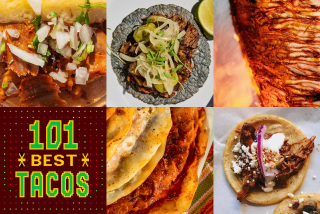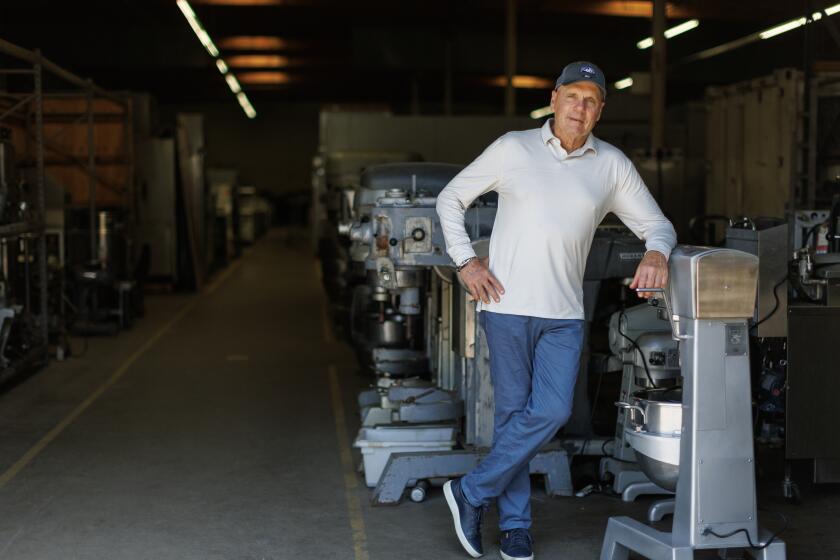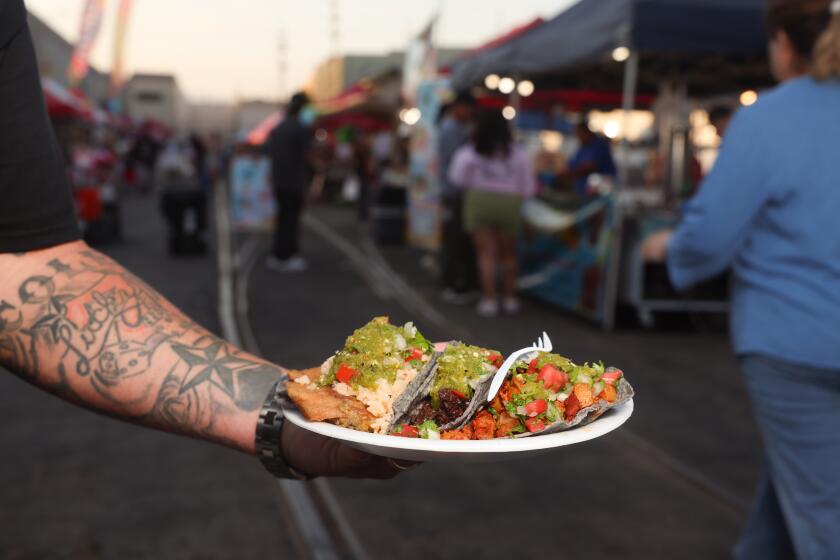Viognier: Rare and Ratty
The hot summer wind blew the aroma of dried grass into the tent and warmed our glasses of Viognier, making it difficult to detect the nuances of peach, apricot, pear and spices in this unique wine.
It was the second annual View From the Vineyards symposium staged by the Viognier Guild, a fledgling organization currently composed of producers of this ratty grape variety, which seems to have no respect for the grower.
“Organization,” in fact, may be an overstatement. The guild was solely the idea of Mat Garretson, a wine lover from Dunwoodie, Ga. Garretson had no ties to the industry (he worked in a family business dealing in contract liquid aerosol products), but he loved wine made from the Viognier grape so much that he announced formation of the guild early in 1993.
At the time, the guild had one member: himself.
*
The first symposium was held May 8, 1993, in Georgia. Among the attendees was John Alban, owner of Alban Vineyards in Arroyo Grande, whose 32 1/2 acres of Viognier in Edna Valley is the largest planting of the variety in the country.
In counting Viognier, every fraction of an acre is important. For all the enthusiasm it is generating among winemakers, astoundingly little land is planted with Viognier.
When she wrote her book “Vines, Grapes and Wine” in 1986, Jancis Robinson noted that there were no more than 80 acres of Viognier in the world--most of it in the area of the Rhone Valley near the town of Condrieu. That has changed significantly, though Viognier acreage is still puny compared with even a grape as obscure as Muller-Thurgau.
The guild estimates that there are now 280 acres of Viognier planted in the United States. In southern France, the well-known Beaujolais producer George Duboeuf has 270 acres of Viognier in the Ardeche, a huge region west of the Rhone. And there are small plantings in Australia and Italy.
The grape has no one but itself to blame. Even its most ardent supporters consider Viognier a degenerate variety, producing only tiny crops of grapes that ripen irregularly and sometimes not at all, no matter how tenderly the grower treats them. Sometimes the grapes gain sugar but have no flavor. Its wines seem not to age very well, or very long. And it’s difficult to make a great wine.
With that as a backdrop, it might seem surprising that more than 150 people from around the world, including the Condrieu producer Daniel Vernay, would show up on this hot day to sample the product of such an obscure and potentially expensive grape. Almost every attendee was affiliated with a winery; only a tiny handful were consumers.
Alban tried to sum up the enthusiasm for Viognier when he said: “Truly great grapes are as rare as oceanfront property. And Viognier is a great grape.”
Garretson, asked to describe the aroma and taste of a great Viognier, said:
“Start with unrivaled hedonistic pleasure. When you try to describe it, it kind of has the aroma of a Riesling but with more spice. And in the mouth it has the weight and texture of a Chardonnay, but with even more grip.
“I guess you could say it’s sort of like Pinot Noir. Both of their aromas are so fascinating, both of them have this elusiveness, and both have these masochistic fanatics who are trying to make a great (wine from them).”
There is no worldwide standard for what a great Viognier is unless one uses a wine such as Chateau Grillet, one of the smallest appellations in France and a wine that I think is ridiculously overpriced at something like $80 a bottle. Occasionally the wine does display the peach/spice aroma I seek in Viognier, but it seems not to stand the test of time.
Because of Grillet’s cost, I rarely taste it, and when I have tasted older versions, I have been disappointed. Some experts claim to find charm in old Viognier, but my best advice is to drink it young.
That peach/spice element I like in young Viognier is difficult to capture unless the winemaker gets exceptional grapes and then treats them gently. Alban admits that “few winemakers have the quality of fruit that can let the grapes stand on their own.” So what has happened in recent years is that many winemakers have taken to treating Viognier just like Chardonnay. The result is a wine heavier than Chardonnay, with a lot of oak and not enough fruit.
The best Viognier I tasted at the symposium was the 1993 Alban “Estate Bottled” ($28); it had stunning, exotic peach fruit and perfect balance. This is the first Alban wine made entirely from his own grapes; clearly it’s the best yet.
I also loved the marvelous 1993 Joseph Phelps ($25), with peach and pear notes and a trace of vanilla from oak aging. Also exciting was 1993 Kunde Estate Winery’s version ($18), with a very soft taste but superb spiced aroma. I also detected a note of hay but wondered whether that may have come from the scent in the air.
The new 1993 Calera Viognier ($30) is stylishly complex, with fruit and oak playing tag. The 1993 Arrowood Vineyards ($25), with apple and apricot nuances and a very rich mouth feel, though higher alcohol (nearly 15%), makes it taste a tad hot.
A real bargain was from Duboeuf’s new planting in France, from the 1993 vintage. Though it was light in the aftertaste, it was fragrant and appealing, and at $8 it is worth trying.
Other fascinating wines: 1993 Domaine des Aspes from France ($13); 1993 Cline Cellars ($17); 1993 Callaway Vineyards ($16); 1992 La Jota Vineyard ($24); 1993 R. H. Phillips Vineyard ($15/500 milliliters), 1993 Qupe ($25), and 1993 Preston Vineyards ($18).
“After the growers and producers, the next group to get excited about any new grape are retailers, restaurateurs and critics,” said Alban, “and I have never seen more jubilant support for a new variety than what they feel for Viognier.”
One Southern California restaurateur doesn’t need persuading. Manfred Krankl of L.A.’s Campanile is a fanatic for Viognier and pleaded to have his restaurant do the lunch for the symposium. His request was granted.
“We all need this diversity, even if it is merely to enhance our enjoyment of what we already have,” concluded Alban. “Maybe this is the first real alternative to Chardonnay.”
More to Read
Eat your way across L.A.
Get our weekly Tasting Notes newsletter for reviews, news and more.
You may occasionally receive promotional content from the Los Angeles Times.






